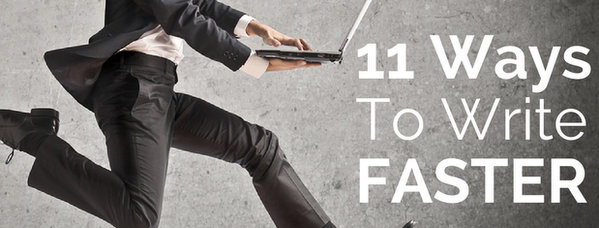Here are 11 ways by Stephanie Palmer to help you write faster improve the speed of your creative process.

1. Develop Your Pitch First
Most people think of their pitch as a tool for selling their screenplay, TV pilot, or novel. This is why most people wait to work on their pitch until just before their first meeting with a decision-maker. Unfortunately, as soon as they start to work on the pitch, they often discover significant issues with the core concept—and tank the meeting.
This can be avoided if you incorporate pitching as part of the creative process. At the point where you feel like you have an idea worth considerable time and energy, that’s when you want to start pitching and discovering any problems with your concept.
2. Clarify Your Theme
How many scenes do you have to throw away because—even if they’re great—they don’t quite “fit” the story?
Clarify your theme by making a specific statement your story will prove or a question your story will answer. When you have written your theme precisely, you’ll write more scenes that are “on point.” (For more on this, see Save The Cat by Blake Snyder, p. 73-74.)
3. Create Your Development Slate
What’s a “Development Slate?”
A slate is a list, and so your Development Slate is an list of all your ideas that relate to your current projects. The idea is that you collect and sort your ideas, and the best, most valuable ideas percolate to the top.
This helps you write faster because you maintain focus on your top creative priorities, free up mental space, and make it easier to find supporting ideas, details, or scenes when you need them.
4. Stack Your Projects
Scott Myers of Go Into The Story has a great post about “stacking projects.” This refers to having multiple projects in development.
Here’s how Myers explains it:
At any given time, you are actively working on three projects:
- The rewrite: This is a project for which you have already written a draft and turned in, and you will edit per studio/producer notes.
- The first draft: This is a project you are working on to get to the studio.
- Prep-writing: This is your next project on which you are doing research, brainstorming, developing characters, and plotting.
5. Never Lose Work
One of the most heart-breaking setbacks for any writer is losing work. This can be from a computer malfunction, natural disaster, power surge, user error, or burglary.
My suggestion is that you protect your work with a solid backup system. The minimum system I recommend is where you have an onsite backup drive and an offsite backup service (e.g. Crashplan, Mozy, or Dropbox).
6. Eliminate Distractions
I know you know, but a post on how to write faster wouldn’t be complete without saying:
- Turn off your phone and email.
- Log out of Twitter, Facebook, and other social media.
- Clear your desk of non-project related clutter.
- Close your door.
7. Invest In Better Input Devices
This means your pens, keyboard, mouse, and mousepad.
Most writers I know are picky about pens. They’ve tried a lot of different pens and, over time, have selected a favorite model. However, they don’t have the same level of discrimination about their keyboard or mouse. Instead, they get used to a certain tool and just keep using it.
Test out the input devices to see what feels best to you. Something to consider are devices marketed to “gamers.” These people play a lot of computer games and have very high standards for speed, accuracy, and ease of use.
8. Invest In A Second (Or Third) Monitor
I recommend having at least two monitors. Having more screen “real estate” lets you write faster because you can keep more documents visible, speed up how quickly you can cut-and-paste, and make it easier to research online.
9. Discover More Keyboard and Mouse Shortcuts
What do you do most often? There’s probably a shortcut to do it faster.
10. Consider Scrivener
There are many different word processing programs out there, but a recent addition to the field has recently been making waves and getting lots of positive reviews. It’s called, “Scrivener.”
This program is designed to help writers manage lots of pieces of information and construct long documents. I know screenwriters and novelists who use Scrivener to compose, then Final Draft or Word to format the material before submitting.
11. Break Down Big Assignments Into Small Tasks
Mark Twain said, “The secret of getting started is breaking your complex overwhelming tasks into small manageable tasks, and then starting on the first one.”
So, instead of “Write draft” you would have smaller tasks like:
- Assemble all project materials
- Come up with three ideas for Catalyst moment
- Brainstorm new obstacles for Chase sequence
- Research travel guidelines for Beijing
To Write Faster, Pitch Earlier
Writing speed is partly about typing speed, and there’s every reason to investigate how different hardware and software can help you.
However, the largest speed increases come from improving your creative process. If you only make one change to how you work, start pitching at an early stage of development. You’ll discover story problems sooner and fix them efficiently. Then, when you start drafting, your story will be clear and you’ll finish more quickly.

